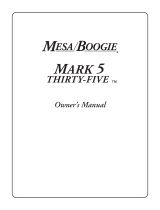
PAGE 10
Channel Modes: (Continued)
PUSHED: This mode is a radical departure from the sweet shimmering blend of the CLEAN / NORMAL modes low gain character. Huge
increases in gain early on in the first stages of the pre-amp produce one of the biggest differences between modes in the entire amplifier
and transforms what you thought to be a tame and gentle clean channel into a raging crunch machine. This incredible amount of gain also
creates one of the most expressive solo modes in your Nomad. Because there are less stages of gain for the signal to travel through and
the tone control network is tuned for the brighter nature of clean sounds, this mode responds quicker to your pick attack and has a more
urgent, snappy feel. Don’t overlook this mode for some of the Nomads’ best overdrive solo sounds.
VINTAGE / NORMAL: The first of Nomads’ high gain lead channels was endowed with an
orange LED indicator not by accident. The warm glow reminded us of smoldering embers...a fire
burning warm with all the comforts of home. Upon first playing Channel 2’s VINTAGE/NORMAL
mode most players stop - grin - and say one word...FAT. This mode has been optimized to round
out single notes and enrich their character with creamy, warm drive. You will quickly discover
that this mode has no optimum setting as it presents the entire range of the control with amazing
balanced lead sounds. Set low ( Gain at 9:30 and below ), it doubles as a low gain chording or
blues sound that purrs with vintage authenticity. From there on up to 3:00, many different styles
of solo sounds are available that work great with either single coil or humbucking pick-ups and
no matter how you serve it up it’s always gonna be big... huge !
MODERN: This mode had its early beginnings in an idea that sprang to life in the late eighties and found its way on to our Dual Rectifier
Solo Head called Channel Cloning. Well, as usual we ended up going far beyond the original idea and now this mode is simply a more
aggressive, over the top, hardcore version of the already monsterous Channel 2 NORMAL mode. This sound is the hugest rock sound in
the Nomad and for all out girth, it tips the scales. The same stylistic ranges apply as those of the NORMAL mode, but the top end of the
GAIN Control unleashes the true beast within, and should be experienced with a hot humbucking pick-up to really appreciate its footprint.
NOTE: Reduce the MASTER Control when switching from VINTAGE NORMAL to MODERN as internal changes
in the circuit increase volume levels dramatically !
MODERN / NORMAL: This mode is the hyper stallion in the Nomad camp. An enhanced
attack region and a brighter overall response combined with a slightly higher low end curve give
Channel 3’s NORMAL mode the edge when it comes to speed and agility. The nature of this
mode is the polar opposite of Channel 2’s languid, slowhand purr.
It bounces to life with the slightest of glances from the pick and can stop on a dime whether
maxed out or running stripped. Again, like Channel 2’s NORMAL, this mode handles low gain
single coil styles and high gain humbuck sounds with equal attitude... and we do mean attitude!
VINTAGE: This “slightly” detuned, warmer rendition of Channel 3’s NORMAL mode makes it
possible to use Channel 3 for some of the sounds you might like in Channel 2 and though the Bass frequencies are a little higher, they are
just as amazing. By offering a way for each channel to lean toward the other, many possible configurations appear and the footswitching
applications are expanded greatly.
You might wish to use Channel 2 NORMAL for a semi-clean rhythm mode and Channel 3 VINTAGE for a blues style solo sound. Con-
versely, you might need Channel 3 NORMAL to cover your high gain ( maybe Channel 1 PUSHED for lower gain ? ) crunch rhythm stuff
- and Channel 2 MODERN for a crazy, blistering solo sound. There are a myriad of ways to configure the Channels 2 & 3 and so many
great combinations of mode swapping that will make your footswitching allocations less confining, freeing you up to play your best.
CH2
MODERN
VINTAGE
(NORMAL)
Channel 2 NORMAL / MODERN
PRESENCE
BASS
MASTER
MID
GAIN
TREBLE
CH 3
VINTAGE
MODERN
(NORMAL)
Channel 3 MODERN / VINTAGE
PRESENCE
BASS
MASTER
MID
GAIN
TREBLE



























